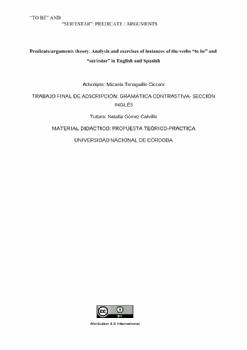| dc.description.abstract | This work is divided into three sections. In the first section, the theory on predicates
and arguments is presented. The main points of the theory are described and key definitions
of essential terms are provided, such as “predicate”, “predicator”, “referring expressions” and
“arguments”. All the concepts and information presented herein are based on authors such as
Lyons (1977a, 1977b), Saeed (2009), Ágel & Fischer (2015), and Hurford, Heasley & Smith
(2007) in the English section, and Di Tullio (2014), Real Academia Española (2010), and
Pinuer Rodríguez (1994) in the Spanish section.
In the second section, the peculiarities of sentences containing the verbs “to be” and
“ser/estar” are analyzed from the perspective of predicates and arguments theory. Before
identifying the verbs “to be” and “ser/estar” as predicators, it is important to know the
distinctions between equative sentences and ascriptive sentences. Different mechanisms to
identify each of the sentences are described in order to establish when the verbs “to be” and
“ser/estar” are considered predicates functioning as predicators. Additional exercises are
included for students to consolidate the theory through practice; that is, exercises are presented to identify key concepts, classify structures such as equative and ascriptive
sentences, point out the predicate functioning as predicator and the elements required to form
grammatically correct sentences. Finally, the exercises provided aim at both distinguishing
between equative and ascriptive sentences and identifying predicates and arguments.
In the third section, the pedagogical framework is presented. The design of the
exercises is in line with the pedagogical approach followed by the Chair:
consciousnessraising (Rutherford & Sharwood Smith, 1981, 1988). Before the exercises, the
theory on consciousness-raising is presented taking into account authors such as Rutherford
(1987), Ellis (2002, 2008) and Willis & Willis (1996). The exercises go first from more
teachermonitored exercises testing theory to recognition exercises and finally to production
exercises. | es |





